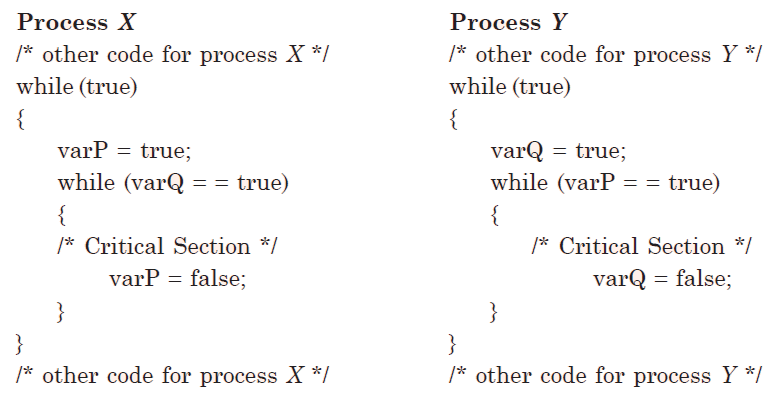OS Process Management
Question 31
The following two functions P1 and P2 that share a variable B with an initial value of 2 execute concurrently.
P1()
{
C = B – 1;
B = 2*C;
}
P2()
{
D = 2 * B;
B = D - 1;
}
The number of distinct values that B can possibly take after the execution isQuestion 32
Question 33
In a certain operating system, deadlock prevention is attempted using the following scheme. Each process is assigned a unique timestamp, and is restarted with the same timestamp if killed. Let Ph be the process holding a resource R, Pr be a process requesting for the same resource R, and T(Ph) and T(Pr) be their timestamps respectively. The decision to wait or preempt one of the processes is based on the following algorithm.
if T(Pr) < T(Ph)
then kill Pr
else wait
Which one of the following is TRUE?
Question 34
A process executes the following segment of code :
for(i = 1; i < = n; i++) fork ();The number of new processes created is
Question 35
The semaphore variables full, empty and mutex are initialized to 0, n and 1, respectively. Process P1 repeatedly adds one item at a time to a buffer of size n, and process P2 repeatedly removes one item at a time from the same buffer using the programs given below. In the programs, K, L, M and N are unspecified statements.
P1
while (1) {
K;
P(mutex);
Add an item to the buffer;
V(mutex);
L;
}
P2
while (1) {
M;
P(mutex);
Remove an item from the buffer;
V(mutex);
N;
}
The statements K, L, M and N are respectively
Question 36
Consider the following two-process synchronization solution.
Process 0 Process 1
Entry: loop while (turn == 1); Entry: loop while (turn == 0);
(critical section) (critical section)
Exit: turn = 1; Exit turn = 0;
The shared variable turn is initialized to zero. Which one of the following is TRUE?Question 37
Consider a non-negative counting semaphore S. The operation P(S) decrements S, and V(S) increments S. During an execution, 20 P(S) operations and 12 V(S) operations are issued in some order. The largest initial value of S for which at least one P(S) operation will remain blocked is ________.
Question 38
In the working-set strategy, which of the following is done by the operating system to prevent thrashing?
- It initiates another process if there are enough extra frames.
- It selects a process to suspend if the sum of the sizes of the working-sets exceeds the total number of available frames.
Question 39
The following is a code with two threads, producer and consumer, that can run in parallel. Further, S and Q are binary semaphores equipped with the standard P and V operations.
semaphore S = 1, Q = 0;
integer x;
producer: consumer:
while (true) do while (true) do
P(S); P(Q);
x = produce (); consume (x);
V(Q); V(S);
done done
Which of the following is TRUE about the program above?Question 40
An operating system implements a policy that requires a process to release all resources before making a request for another resource. Select the TRUE statement from the following:
There are 115 questions to complete.
Last Updated :
Take a part in the ongoing discussion
